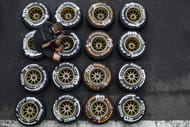With eight races to go in the current F1 calendar, the heat is already on for the Driver’s Championship. If you thought that was the only thing on the minds of the teams and drivers, hang On!! Enter ‘Tyre Wars’ for 2014.
While the Belgian GP might not have offered the kind of excitement that’s been linked with the beautiful Spa Circuit , news of Michelin’s return in 2014 has spiced things up and given way to the tyre war in Formula One.
Pirelli, the current tyre suppliers to the teams in Formula One, were under a lot of scrutiny thanks to the remarkable tyre blow outs (a jaw dropping six) at the British Grand Prix . As expected, teams were furious and Pirelli had to take corrective action. The Italian manufacturer managed to hush down the criticism at the Young Driver’s Test held at Silverstone last month. Though there haven’t been any alarm bells in the couple of races preceding the tests, Pirelli find themselves seeing down the barrel with Michelin coming into the picture. Here’s a take on whether having multiple tyre suppliers is a good idea or a single supplier is the better option for Formula One.
Two Elephants under One Roof or Should the Lion be In-charge?
2013 is Pirelli’s third year as a sole tyre supplier for Formula One and they were sailing along fine until they made headlines thanks to the Tyre-gate controversy, when they privately tested with Mercedes, and the drama at Silverstone. Formula One is not new to the idea of having two suppliers; Bridgestone and Michelin managed to share the supplies until 2006, before Michelin quit with the FIA (Formula One Regulatory Body) announcing their policy of having a sole tyre supplier for 2008. Michelin were in the midst of a controversial storm in 2005 due to a horrific accident involving Ralf Schumacher, which raised issues of tyre safety at the United States GP. Bridgestone continued with their support until 2010 after which Pirelli was chosen as the single supplier of tyres.
From a team and driver’s perspective it makes a lot of sense to have different tyres options to choose from. But that’s easier said than done. With two suppliers, the efficiency of the tyres is expected to increase, but so will the testing and development cost for the teams to afford both and with some of the teams financially drained, a second supplier at this point doesn’t serve as a viable option. Also, a single tyre supplier makes way for a level playing field for all the teams without any of the teams getting any undue advantage.
F1 Grand Prix of Belgium – Qualifying
Pirelli went under the scanner for the recent tyre debacle. Michelin, too, have had their share of controversies in Formula One and have been quite vocal of their concerns over the current supply of tyres by Pirelli which degrade quickly, artificially helping in increased overtaking and making pit-stops a tactical element during the race. But that’s what Pirelli have been asked to provide by the FIA.
Previews for the French Grand Prix
Michelin has emerged as a possible Tyre Supplier for the 2014 season. Moreover, Michelin have shown their discomfort in supplying the current set of 13-inch tyres and would want their 18-inch tyres instead (which would have an impact on the suspension configuration and the gearbox). Though Michelin have reportedly done away with their rigidness and are open to both a single or shared supplier option, they are expected to force their technologically advanced slick wet tyres into use. Pirelli however, would be averse to the idea of sharing their duties. Another twist in the tale is that Jean Todt, the FIA President, has been linked to having a soft-corner for Michelin(blame it on the French connection).
Pirelli have a commercial contract with Bernie Ecclestone (Chief of Fomula One Management) and a deal with most of the teams (there may be opt-out options in these contracts in-case FIA decides to have 2 suppliers). The agreement, however, with FIA-the regulatory body, as the official supplier is yet to be inked. Pirelli continue to be on the job to develop their tyres for next year and with current set of affairs it does make sense for them to continue in Formula One at least for 2014, if not later. A two supplier model can be worked for the 2015 season after a healthy analysis with concurrence from the teams and if it is in the best interest of the sport.
The clock as of now is ticking and the situation at hand seems quite comical yet dangerous. Between all the speculation and the confusion, the teams have to develop their cars for the next season and are yet to know about their tyre supplier and the configuration of a critical component. By the look of it, if the matter isn’t resolved quickly, wer are bound to have a comedy of errors sooner or later.
